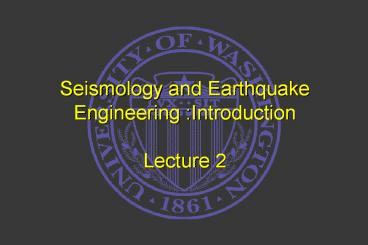Seismology%20and%20Earthquake%20Engineering%20:Introduction%20Lecture%202 - PowerPoint PPT Presentation
Title:
Seismology%20and%20Earthquake%20Engineering%20:Introduction%20Lecture%202
Description:
Shakes ground horizontally. and vertically. Wave damages structures. Similar to 'S' wave ... Shakes ground vertically. and horizontally. Arrives first ... – PowerPoint PPT presentation
Number of Views:1205
Avg rating:3.0/5.0
Title: Seismology%20and%20Earthquake%20Engineering%20:Introduction%20Lecture%202
1
Seismology and Earthquake Engineering
IntroductionLecture 2
2
Basic Concepts of Seismology
Elastic rebound theory Plates are in continuous
motion Stresses and strains build up near
boundaries Strain energy stored in crust near
faults, then released Aseismic movement - slow
creep in ductile rock Seismic movement - rupture
of brittle rock
3
Basic Concepts of Seismology
Seismic Gaps
Loma Prieta Gap
San Francisco
San Juan Bautista
Portola Valley
Loma Prieta
Parkfield
1969-89 seismicity
4
Basic Concepts of Seismology
Seismic Gaps
Loma Prieta Gap
San Francisco
San Juan Bautista
Portola Valley
Loma Prieta
Parkfield
Loma Prieta earthquake and aftershocks
5
Basic Concepts of Seismology
Seismic Gaps
6
Basic Concepts of Seismology
Near-field effects
Directivity
Rupture moving away from observer
Rupture moving toward observer
7
Basic Concepts of Seismology
Near-field effects
Fault parallel
Directivity
Fault normal
Fault normal accelerations exceed fault parallel
accelerations
8
Basic Concepts of Seismology
Earthquake size
Intensity - qualitative measure of observed
effects Modified Mercalli Intensity (MMI)
MMI IV During the day felt indoors by many,
outdoors by few at night some awakened dishes,
windows, doors disturbed walls make cracking
sound sensation like heavy truck striking
building standing motor cars rocked noticeably
9
Basic Concepts of Seismology
Earthquake size
Intensity - qualitative measure of observed
effects Modified Mercalli Intensity (MMI)
MMI IV During the day felt indoors by many,
outdoors by few at night some awakened dishes,
windows, doors disturbed walls make cracking
sound sensation like heavy truck striking
building standing motor cars rocked noticeably
MMI VII Everybody runs outdoors damage
negligible in buildings of good design and
construction, slight to moderate in well-built
structures, considerable in poorly built or badly
designed structures some chimneys broken
noticed by persons driving motor cars
10
Basic Concepts of Seismology
Earthquake size
Intensity - qualitative measure of observed
effects Modified Mercalli Intensity (MMI)
MMI IV During the day felt indoors by many,
outdoors by few at night some awakened dishes,
windows, doors disturbed walls make cracking
sound sensation like heavy truck striking
building standing motor cars rocked noticeably
MMI VII Everybody runs outdoors damage
negligible in buildings of good design and
construction, slight to moderate in well-built
structures, considerable in poorly built or badly
designed structures some chimneys broken
noticed by persons driving motor cars
MMI X Some well-built wooden structures
destroyed most masonry and frame structures
destroyed with foundations ground badly cracked
rails bent landslides considerable from river
banks and steep slopes shifted sand and mud
water splashed over banks
11
Basic Concepts of Seismology
Seismic waves
p-waves
Body waves
s-waves
Love waves
Surface waves
Rayleigh waves
12
Basic Concepts of Seismology
Earthquake size
Magnitude - quantitative measure of size of
event Several types Local magnitude Body wave
magnitude Surface wave magnitude
All based on instrumental measurements
13
Basic Concepts of Seismology
Earthquake size
Seismic moment - measure of work done by eq. Mo
m A D where m shear modulus of rock A
rupture area D average displacement over
rupture area Units F/L2 x L2 x L F x L
Work Energy
14
Basic Concepts of Seismology
Earthquake size
Magnitude saturation
15
Earthquake Size
16
Seismic Waves
- Arrives first
- Sometimes audible
- Shakes ground horizontally
- and vertically
- Wave damages structures
- Similar to S wave
- Moves ground horizontally
- Like rolling ocean wave
- Shakes ground vertically
- and horizontally
17
Seismic Waves
Strong motion seismograph
18
Seismic Waves
Triaxial accelerometers 3 components
Horizontal motions are very important
19
So What?
- Deaths and injuries
- Economic loss































